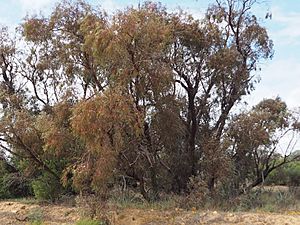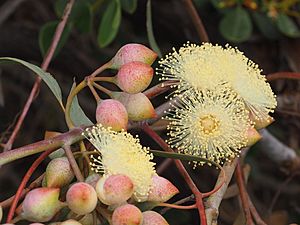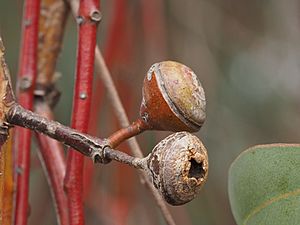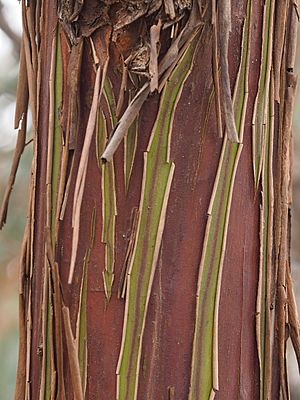Silver mallee facts for kids
Quick facts for kids Silver mallee |
|
|---|---|
 |
|
| Scientific classification | |
| Genus: |
Eucalyptus
|
| Species: |
crucis
|
Eucalyptus crucis is a special type of mallee tree. It is found only in Western Australia. This means it is endemic to that area. People often call it the silver mallee or Southern Cross mallee. There are three slightly different types, called subspecies.
This tree has rough bark that peels off in curly pieces. Its young leaves are round and have a grey-blue color, like they're covered in a fine dust. Older leaves are shaped like an egg or a spear. The bark and the mix of leaf types on a grown tree can be different for each subspecies. Its flower buds grow in groups of seven. The flowers are usually whitish or light yellow. After flowering, it grows fruit that looks like a cone or a half-sphere.
Contents
What the Silver Mallee Looks Like
The Eucalyptus crucis is a mallee tree that usually grows between 2 and 15 meters tall. It has a special woody swelling at its base called a lignotuber. This helps it regrow after a fire.
Its bark is a rich, reddish-brown and feels rough. For some types of this tree, the bark peels off in curly pieces about 10 cm wide. This is known as "minni ritchi" bark.
Leaves of the Silver Mallee
Young plants and new shoots often have round leaves. These leaves are usually grey-blue and grow in opposite pairs. They are about 1.7 to 5.5 cm long and 1.3 to 6.5 cm wide.
Leaves that are a bit older are egg-shaped or spear-shaped. They can be up to 6.5 cm long and 2 to 5.5 cm wide. These leaves have a short stem.
Fully grown leaves are spear-shaped and grow one after another along the branch. They are 5 to 10 cm long and 0.8 to 2 cm wide. They have a stem that is 0.5 to 1.5 cm long.
Flowers and Fruit
The flower buds grow in groups of seven in the leaf corners. Each group sits on a stalk that is 7 to 16 mm long. Each individual bud has its own small stem, about 4 to 6 mm long.
When the buds are ready to open, they are oval-shaped. They are about 9 to 15 mm long and 6 to 8 mm wide. They have a cap that is shaped like a cone or is rounded, about 5 to 8 mm long.
The tree flowers between September and March. After the flowers, it grows woody fruit. These fruits are shaped like a cup or a half-sphere. They are 5 to 8 mm long and 10 to 15 mm wide.
How the Silver Mallee Got Its Name
The Eucalyptus crucis was first officially described in 1923. A scientist named Joseph Maiden wrote about it. He used a sample collected by Henry Steedman in 1922 near a place called Southern Cross.
The name crucis comes from a Latin word meaning "cross." This name was chosen because the first sample of the tree was found near Southern Cross.
Different Types of Silver Mallee
In 1982, two other scientists, Ian Brooker and Stephen Hopper, found two different types of this tree. They called them subspecies crucis and lanceolata. Later, in 1993, they found a third type, subspecies praecipua. All three types are now officially recognized.
Here's how you can tell them apart:
- Eucalyptus crucis subspecies crucis has a top part (crown) made mostly of those grey-blue young leaves.
- Eucalyptus crucis subspecies lanceolata has a crown made of grey-green adult leaves.
- Eucalyptus crucis subspecies praecipua also has a crown of adult leaves, but they are bigger than those of subspecies lanceolata. Also, its "minni ritchi" bark is only found on the thinner branches.
Where the Silver Mallee Lives
The silver mallee grows in parts of the Goldfields-Esperance and Wheatbelt regions of Western Australia. It likes sandy, clay, or loam soils. You can often find it growing near large granite rocks.
It often grows with other plants like sheoak (Allocasuarina species), wattle (Acacia species), and one-sided bottlebrush (Calothamnus species).
Specific Locations for Each Subspecies
- Subspecies crucis is only found between Merredin, Southern Cross, and Westonia.
- Subspecies lanceolata grows between Corrigin, Mount Churchman, and Chiddarcooping Rock.
- Subspecies praecipua is only known from near Paynes Find.
Protecting the Silver Mallee
The subspecies lanceolata is considered "not threatened," which means it's doing well. However, subspecies crucis and praecipua are listed as "Threatened Flora" by the Department of Environment and Conservation (Western Australia). This means they are rare and need protection.
Subspecies crucis (silver mallee) is also listed as "vulnerable" under a special Australian Government law called the Environment Protection and Biodiversity Conservation Act 1999. This means it's at risk of becoming endangered.
The main dangers to this subspecies are:
- People doing activities that disturb its habitat.
- Work on pipelines that go through its living areas.
- Animals eating too much of the plants.
- Weeds growing and taking over its space.
How People Use the Silver Mallee
This type of eucalypt is very useful! It can handle cold weather (frost) and dry periods (drought). It also grows well in soils that are high in salt.
People often use it for many things:
- As a windbreak to protect other plants or buildings from strong winds.
- As a street tree in towns.
- For its pretty fruit, which can be decorative.
- To help stop soil from washing away (erosion control).
- As a plant that produces honey for bees.
- As a safe place for birds to build their nests.




